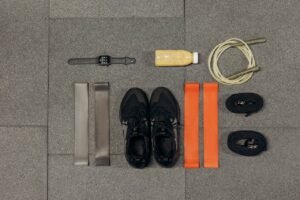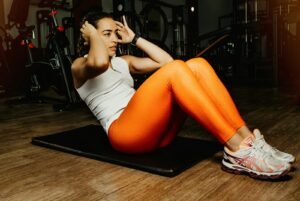So, you’ve decided to work out at home. Maybe the gym is too far or too crowded. Or perhaps you’re just not into the whole “sweaty stranger grunting on the next machine” scene. Whatever your reason, welcome!
You’re about to create a workout space that’s entirely your own—no waiting for a bench press, no mysterious locker room smells, and best of all, no commute.
With the right home workout equipment, your fitness journey can be exciting and personalized.
Choosing the best home workout equipment will set the stage for your success.
Your choice of home workout equipment can greatly enhance your results and keep you motivated.
Setting up your home workout equipment can be fun and rewarding.
Using home workout equipment like resistance bands can transform your fitness routine.
The best part? You don’t need to drop a fortune or dedicate an entire room to look like a CrossFit box.
With just a few innovative tools, you can build a home gym that supports your goals and grows with you. Here’s your beginner-friendly guide to building a gym that’s effective, space-conscious, and maybe even fun.
Integrating various home workout equipment into your regimen can elevate your training.
Resistance Bands: The Pocket-Sized Powerhouse
Think of resistance bands as your fitness Swiss Army knife—compact, versatile, and surprisingly powerful. Whether you’re new to working out or easing back in, resistance bands offer a gentle, joint-friendly way to build strength and improve mobility.
Why They Work
Incorporating dumbbells as essential home workout equipment can help you achieve your fitness goals.
Unlike dumbbells that rely on gravity, resistance bands provide continuous tension throughout your entire movement. That means your muscles are working the whole time, not just at the top of a rep. Sometimes called time under tension, it’s like having a personal trainer accompany every exercise, who politely says, “Nope, still not done yet.”
They’re perfect for:
Squats and glute work
Rows and shoulder exercises
Chest presses
Warmups and cooldowns
Mobility drills and rehab
Most bands are color-coded by resistance level (e.g., yellow = “this is fine,” black = “why do my arms hate me?”). Start light and progress gradually.
Extra Bonus
Resistance bands are the ultimate travel companion for your fitness routine. They’re lightweight, flexible, and roll up tighter than a burrito, making them incredibly easy to store and transport. Whether you’re heading on vacation, traveling for work, or just short on space at home, these compact bands turn any room—hotel, office, or living room—into a mini gym. No bulky equipment, no special setup—grab your band and go. You can sneak in a full-body workout on your lunch break or keep your routine going from a beachside Airbnb. Wherever life takes you, resistance bands go too—quietly judging your excuses.
Dumbbells: The Old-School Favorite That Still Delivers
Consider the size and storage options for your home workout equipment when designing your space.
Ah, dumbbells. Classic, reliable, and a little intimidating until you realize they’re just fancy paperweights with a purpose. Whether you’re lifting two pounds or twenty-five, dumbbells are one of the best investments you can make.
Why They Work
Dumbbells allow for natural movement patterns and activate stabilizing muscles. This leads to better coordination and injury prevention. That’s a fancy way of saying they help your whole body work together instead of muscling through with poor form.
With dumbbells, you can:
- Build foundational strength (curls, presses, squats)
- Focus on unilateral movements (like single-arm rows or lunges)
- Progressively increase resistance as you get stronger
Beginner Tip
Consider adding a stability ball to your home workout equipment collection for even more variety.
Adjustable dumbbells are a game-changer. Instead of buying multiple sets, you get one compact unit that you can dial up or down as needed.
If you prefer the simplicity of fixed weights, start with a light pair (5–10 lbs) and a medium pair (10–20 lbs), depending on your strength level. I actually learned about adjustable dumbbells from my son. But I had already invested quite a few dollars in individual dumbbells and didn’t want to start over.
However, if I were building a new home gym, I would get the adjustable dumbbells. They take up less space and are quick to change weights.
I actually learned about adjustable dumbbells from my son, but I had already invested quite a few dollars in individual dumbbells and didn’t want to start over. However, if I were building a new home gym, I would get the adjustable dumbbells. They take up less space and are quick to change weights.
It looks like a giant beach ball, but don’t let that fool you. A stability ball is a serious tool for improving your core, posture, and overall coordination. All while keeping your workouts engaging and, yes, a little more fun.
It looks like a giant beach ball, but don’t let that fool you. A stability ball is a serious tool for improving your core, posture, and overall coordination—all while keeping your workouts engaging and, yes, a little more fun.
Why It Works
Because it’s unstable, your body constantly has to adjust to stay balanced. That means more muscles fire at once, especially your core. The result? Better strength and stability, without the boredom of crunches.
Great for:
Seated core work (ball crunches, Russian twists)
Balance challenges (planks, pushups, bird-dogs)
Stretching and back support
Active sitting (goodbye, office chair slouch)
Quick Tip
Make sure you get the right size. When seated on the ball, your knees should be at a 90-degree angle. And always inflate it to firmness, not “bounce castle” bouncy, but not squishy either.
Your yoga mat is vital home workout equipment that enhances your sessions.
Jump Rope: Small But Mighty Cardio
Let’s take it back to the playground—but with better coordination and maybe some real goals this time. A jump rope is one of the most underrated tools in the home gym world. It’s affordable, effective, and fits in your kitchen drawer.
Why It Works
Your yoga mat is essential home workout equipment for any fitness enthusiast.
Experimenting with different home workout equipment can lead to exciting new routines.
Jumping rope is a total-body workout that burns calories, improves cardiovascular endurance, and enhances agility and coordination. In just 10 minutes, you can torch as many calories as a 30-minute jog—without needing a treadmill.
Perfect for:
Quick cardio sessions
HIIT workouts
Warmups and finishers
Improving footwork and timing
Beginner Tip
Adding resistance bands as part of your home workout equipment can maximize your strength training.
Begin with a basic, lightweight rope and start with single jumps. Keep your arms relaxed and your wrists doing the work. Don’t worry if you trip—it’s a rite of passage. You’ll be crushing double-unders in no time.
Yoga Mat: Your Fitness Floor Foundation
If your workout space has hard floors (or you’re just not into bruised knees), a yoga mat is a must. And even if you don’t practice yoga, this humble piece of foam still earns its place in your home gym.
Investing wisely in home workout equipment will pay off in your fitness journey.
Why It Works
A good yoga mat:
Provides cushioning for joints during floor work
Prevents slipping during sweaty sessions
Defines your workout space (important for motivation)
It is lightweight and easy to store
You’ll use it for:
Yoga and stretching
Core work (planks, crunches, leg raises)
Bodyweight workouts
Meditation and cool-downs
What to Look For
A good yoga mat:
- Provides cushioning for joints during floor work
- Prevents slipping during sweaty sessions
- Defines your workout space (important for motivation)
- It is lightweight and easy to store
You’ll use it for:
- Yoga and stretching
- Core work (planks, crunches, leg raises)
- Bodyweight workouts
- Meditation and cool-downs
Bonus Items (Nice to Have, Not Essential)
Once you’ve got your basics down, you may want to add a few extras. These aren’t must-haves, but they’ll elevate your setup:
Foam Roller: Great for muscle recovery and tension release.
Kettlebell: Adds a dynamic element to workouts—swings, snatches, and functional strength galore.
Adjustable Bench: For more exercise variety (chest presses, incline work, hip thrusts).
Pull-Up Bar: Mounted or doorway. A solid way to build upper body and core strength.
Sliders or Gliders: For dynamic bodyweight movements (lunges, planks, mountain climbers).
Building Your Home Gym: A Room-By-Room Reality Check
Evaluate how your home workout equipment aligns with your personal fitness goals.
Personalizing your home workout equipment will ensure you have everything you need at hand.
Essential Home Workout Equipment
The beauty of home fitness? It’s adaptable. Here’s how to make the most of whatever space you’ve got:
Living Room
Keep equipment tucked in a basket or behind the couch
Roll out your yoga mat for workouts and roll it back when done
Use furniture for step-ups or incline pushups
Ultimately, the best home workout equipment is what fits your lifestyle and preferences.
Bedroom
Resistance band and bodyweight workouts fit easily in tight spaces
Foam roller fits under the bed
Small corner = meditation zone + yoga mat = wellness win
Garage or Basement
Install shelving or hooks to store gear vertically
Use an old rug or rubber mat for a makeshift training zone
Ideal for adding bigger gear (bike, bench, etc.) later
Small Apartment
Prioritize compact tools: resistance bands, jump rope, sliders
Foldable mats or under-bed storage options are your best friends
Don’t underestimate how much you can do in a 6×6 foot space
What to Consider Before You Buy
Before hitting “add to cart” on every piece of gear with a 5-star review, pause and think about these:
- Goals: Are you focusing on strength, mobility, cardio, or a bit of everything?
- Space: Do you have room to jump around—or do your workouts need to be quiet and compact?
- Budget: You can get a great starter kit for under $100—resistance bands, mat, jump rope, and one pair of dumbbells.
- Consistency: Start small, use what you have often, and build gradually.
Final Thoughts: Fitness on Your Terms
Creating a home gym doesn’t have to be overwhelming or expensive. With a few key tools, you can build a powerful, flexible space that works for you—whether you’re squeezing in a morning workout between Zoom calls or turning your garage into a weekend warrior zone.
Here’s the truth: It’s not about the equipment itself. It’s about what you do with it.
A resistance band is just rubber until you show up with intention. A dumbbell doesn’t build strength by sitting in the corner. A jump rope can’t boost your cardio if it stays in the drawer.
Start small. Be consistent. Celebrate the little wins (even if it’s just not tripping over your stability ball today).
Your home gym is more than a room—it’s a promise to yourself. And with these beginner-friendly essentials, that promise just got a lot easier (and more fun) to keep.





